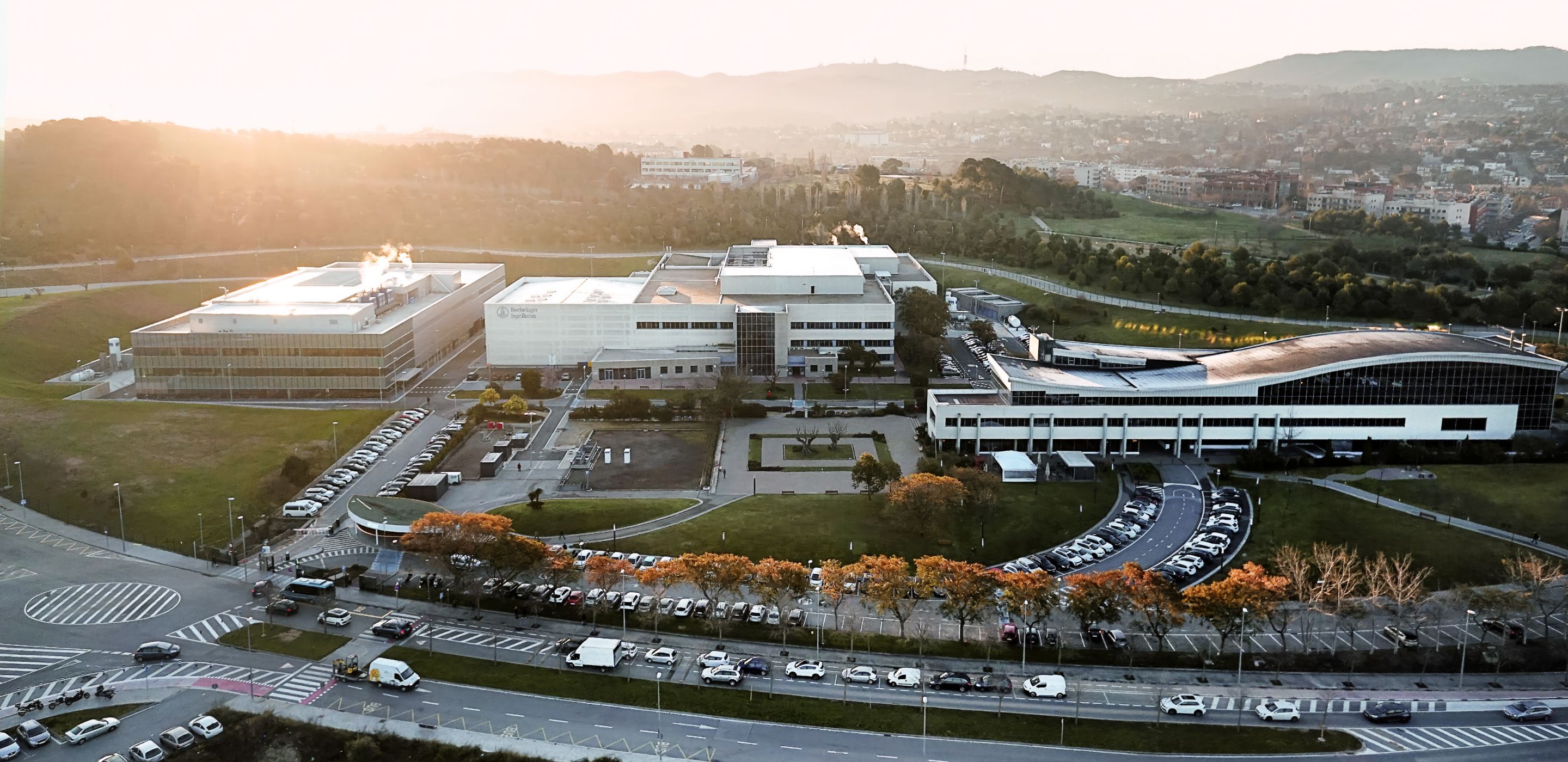

Every drop counts
Catalonia, Spain, is a place known for its beautiful architecture, a rich mix of cultures, pleasant weather and incredible food.
Today, it is also where access to water has become an increasing challenge. In 2020, the area declared a regional climate emergency. By early 2024, Catalonia had suffered 1,000 consecutive days of drought, leading to record low water levels and staggering costs for the government. Broadly speaking, Spain is now facing the threat of desertification across large parts of its territory.
At the Boehringer’s production site at Sant Cugat – a suburb just 15 minutes over the hills from Barcelona – the challenges of water scarcity are real, pushing the issue to the top of the facility’s agenda. “Without clean water, we cannot produce anything,” says Dr. Vasileios Markantonis, Senior Manager for Water and Energy at Boehringer Ingelheim.
“Secure access to clean water is vital for continued production; water plays such an important role both in the production of pharmaceuticals and the operating of the facilities."
“We look at water use holistically, recognize the problem and take action to be more responsible – considering the entire water use cycle from source to end.”
Dr. Vasileios Markantonis, Senior Manager for Water and Energy at Boehringer Ingelheim
From water crisis to water stewardship
Slow, often hard to detect, but increasingly rapid climate change is forcing the company to address mounting water issues. Droughts are lasting longer, floods happening more often and wildfires proliferating in their wake. This threatens the environment, as well as the lives and health of people and animals in the communities around the globe where Boehringer operates.
Water scarcity has become a particular challenge at the Boehringer’s production plants. These are not problems one company can solve alone.
They demand a community-wide and regional approach that can only be solved by also addressing supply issues across catchment zones – the area from which surface rainwater flows into a single drainage system, be it a river, basin or reservoir.
This approach is known as water stewardship.
“We all need to use water resources more sustainably,” explains Dr. Markantonis. “There is no other way. Even in places where we currently have enough water resources, water scarcity might hit in 30, 50 or 100 years. For some ground water reservoirs, it can take hundreds or thousands of years to regenerate.”
That is why the company works actively to protect clean water and further reduce our water footprint in all communities where we operate.
Boehringer Ingelheim is committed to 100% protection of clean water by mitigating pharmaceuticals in wastewater from production and combating antimicrobial resistance, as one part of the company’s MORE GREEN environmental program.
“We look at water use holistically, recognize the problem and take action to be more responsible – considering the entire water use cycle from source to end,” Dr. Markantonis explains.
of clean water.
A holistic water management approach
Boehringer is a member of the Alliance for Water Stewardship, an independent non-profit organization that has created the “AWS Standard”. This is considered today to be the leading standard for corporate water stewardship in water stressed regions. This is the only certification that considers water usage both on-site and across entire catchment areas; and advocates for multi-stakeholder collaboration, including governments, industries, environmental organizations and local communities. Boehringer is the first pharmaceutical company to certify a production site with the AWS Standard.
“The AWS certification has been a gamechanger for water management, and we are already implementing the AWS Standard in production sites that are located in catchments with high water scarcity,” says Dr. Markantonis.
To date, five of the company's production sites are located in areas with high water risk: Xochimilco (Mexico), Fremont (California, USA), Sant Cugat (Spain), Koropi (Greece) and Shanghai (China). And work is currently underway to have all sites AWS certified by 2030.
“In addition, we are continuously evaluating the water risk at all our sites,” Dr. Markantonis adds. “Even if things are currently under control, there is always potential for water risks in the future.”
“The AWS certification has been a gamechanger for water management, and we are already implementing the AWS Standard in production sites that are located in catchments with high water scarcity.”
Dr. Vasileios Markantonis, Senior Manager for Water and Energy at Boehringer Ingelheim

Boehringer Ingelheim’s production site in Xochimilco: The world’s first pharmaceutical production site to be certified for water stewardship by AWS.
“We want to be a role model and show other community members that more sustainable behavior and AWS certification is possible.”
Marcela Gutierrez, Environment, Health and Safety Manager at Boehringer Ingelheim
Mexico: Setting an example for the pharmaceutical industry
One can already recognize the effects of improved water stewardship at the company’s 50-year-old production site in Mexico, where 1,200 employees work.
Xochimilco is home to the famous floating gardens and canals of Mexico City, where colorful, gondola-like boats carry tourists along the remnants of a vast water transport system built by the Aztecs. Xochimilco, which means “where the flowers grow”, is a once semi-rural district of Mexico’s capital city which suffers from shrinking water tables, disappearing canals, rising urban poverty and illegal encampments in an area where 78% of the area is designated as ecological reserves and a sanctuary for North American migratory birds.
Five years ago, the company decided to make the Xochimilco facility the first pharmaceutical production site in the world to receive an AWS certification. “As AWS opened up for pharmaceutical industry, it was an easy decision,” says Marcela Gutierrez, Xochimilco’s Environment, Health and Safety Manager.
Implementation of the AWS Standard has led to improved water usage on site and the fostering of increased collaboration between stakeholders within the Valley of Mexico catchment basin. “We want to be a role model and show other community members that more sustainable behavior and AWS certification is possible,” Gutierrez adds with a smile.
Interesting to know: Essential principles of water management
One part of water stewardship is to improve water usage on site and implement water efficiency measures. At production facilities, Life Cycle Assessments and Eco-Design are used to accomplish this.
Life Cycle Assessments allows us to evaluate a product’s environmental impact throughout its life cycle, from the extraction of resources to disposal.
Eco-Design helps us develop products and operations that reduce, reuse, and recycle water resources and have the lowest possible environmental burden.
California: Getting involved to tackle the omnipresent drought
Approximately 3,500 kilometers northeast of Xochimilco, is Boehringer’s only biopharmaceutical development and manufacturing production site in the United States, and there Shayla Bergeron, Senior Manager Environment, Health and Safety for the Fremont, California facility, is located.
In the last decade, California has seen extensive droughts, record-low water levels, and reduced clean water access for nearly one million residents. “The situation is unsustainable, there are no easy or obvious solutions. But we know we need to step up and ensure we are part of that solution,” Shayla explains.
In 2022, the Fremont site became Boehringer’s second facility to be granted an AWS certification. Implementation of the water stewardship standard has benefited the site’s water performance in various ways. By improving the operational efficiency of its cooling tower, for example, the site estimates a saving of more than 40,000 liters of water per day.
Meanwhile, in addition to collaborating with local water authorities, the team is engaging and educating San Francisco Bay Area residents through organized volunteer events. “Our goal is to reduce and streamline water usage, but also ignite meaningful conversations that can lead to positive change,” Bergeron adds.

At the Sant Cugat site, water usage has been cut by 16% since the beginning of 2023, and they are far from done.
Spain: Ongoing efforts to reduce water footprint
Back in Spain, following the drought challenges of recent years, the company’s production site at Sant Cugat has managed to cut water usage by 16% since the beginning of 2023 and recovered 24,476 m3 of clean water from production processes. “By following the AWS principles, we see the potential to support a more sustainable development in the whole catchment area and make us more resilient for the future,” says Monica Sanchez, Head of Environment, Health, Safety and Sustainability at Sant Cugat.
“Sustainable water management is crucial. Not only for the environment, but also for the business,” sums up Dr. Markantonis.

